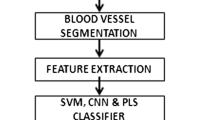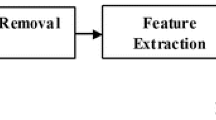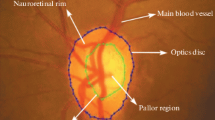Abstract
A condition in which the optic nerve inside the eye is swelled due to increased intracranial pressure is known as papilledema. The abnormalities due to papilledema such as opacification of Retinal Nerve Fiber Layer (RNFL), dilated optic disc capillaries, blurred disc margins, absence of venous pulsations, elevation of optic disc, obscuration of optic disc vessels, dilation of optic disc veins, optic disc splinter hemorrhages, cotton wool spots and hard exudates may result in complete vision loss. The ophthalmologists detect papilledema by means of an ophthalmoscope, Computed Tomography (CT), Magnetic Resonance Imaging (MRI) and ultrasound. Rapid development of computer aided diagnostic systems has revolutionized the world. There is a need to develop such type of system that automatically detects the papilledema. In this paper, an automated system is presented that detects and grades the papilledema through analysis of fundus retinal images. The proposed system extracts 23 features from which six textural features are extracted from Gray-Level Co-occurrence Matrix (GLCM), eight features from optic disc margin obscuration, three color based features and seven vascular features are extracted. A feature vector consisting of these features is used for classification of normal and papilledema images using Support Vector Machine (SVM) with Radial Basis Function (RBF) kernel. The variations in retinal blood vessels, color properties, texture deviation of optic disc and its peripapillary region, and fluctuation of obscured disc margin are effectively identified and used by the proposed system for the detection and grading of papilledema. A dataset of 160 fundus retinal images is used which is taken from publicly available STARE database and local dataset collected from Armed Forces Institute of Ophthalmology (AFIO) Pakistan. The proposed system shows an average accuracy of 92.86% for classification of papilledema and normal images. It also shows an average accuracy of 97.85% for classification of already classified papilledema images into mild and severe papilledema. The proposed system is a novel step towards automated detection and grading of papilledema. The results showed that the technique is reliable and can be used as clinical decision support system.


















Similar content being viewed by others
References
Tannenbaum, D.W., and Mandelcorn, M.S., Abnormalities of the optic fundus. Can. Fam. Physician. 36:729, 1990.
Ohle, R., McIsaac, S.M., Woo, M.Y., and Perry, J.J., Sonography of the optic nerve sheath diameter for detection of raised intracranial pressure compared to computed tomography a systematic review and meta-analysis. J. Ultrasound Med. 34:1285–1294, 2015.
Tallitsch R. B. , Martini F., and Timmons M. J., Human anatomy, ed: San Francisco: Pearson/Benjamin Cummings, 2006.
Traboulsi E. I., Genetic diseases of the eye: Oxford University Press, 2011.
Jonas, J.B., Budde, W.M., and Panda-Jonas, S., Ophthalmoscopic evaluation of the optic nerve head. Surv. Ophthalmol. 43:293–320, 1999.
Riordan-Eva, P., Clinical assessment of optic nerve disorders. Eye. 18:1161–1168, 2004.
Cameron, A.J., Marked papilloedema in pulmonary emphysema. Br. J. Ophthalmol. 17:167, 1933.
Corbett, J.J., and Mehta, M., Cerebrospinal fluid pressure in normal obese subjects and patients with pseudotumor cerebri. Neurology. 33:1386–1386, 1983.
Wall, M., Idiopathic intracranial hypertension. Neurol. Clin. 28:593–617, 2010.
Jogi, R., Basic Ophthalmology: Jaypee Brothers Medical Publishers, 2009.
Şahin, A., Cingü, A.K., Ari, Ş., Çinar, Y., and Çaça, İ., Bilateral optic disc drusen mimicking papilledema. J. Clin. Neurology. 8:151–154, 2012.
Wall, M., and GEORGE, D., Idiopathic intracranial hypertension. Brain. 114:155–180, 1991.
Atta, H., Imaging of the optic nerve with standardised echography. Eye. 2:358–366, 1988.
Kurz-Levin, M.M., and Landau, K., A comparison of imaging techniques for diagnosing drusen of the optic nerve head. Arch. Ophthalmol. 117:1045–1049, 1999.
Alexander, L., Congenital and acquired anomalies of the optic nerve head, Primary Care of the Posterior Segment, pp. 1–68, 1994.
Auw-Haedrich, C., Staubach, F., and Witschel, H., Optic disk drusen. Surv. Ophthalmol. 47:515–532, 2002.
Byrne, S. and Green, R., Ultrasound of the eye and orbit. Mosby, Inc., St. Louis, vol. 273, 2002.
Schuman, J.S., Puliafito, C.A., Fujimoto, J.G., and Duker, J.S., Optical coherence tomography of ocular diseases. Slack Thorofare, NJ, 2004.
Wang, J.-K., Kardon, R.H., Kupersmith, M.J., and Garvin, M.K., Automated quantification of volumetric optic disc swelling in papilledema using spectral-domain optical coherence tomography volumetric quantification of optic disc swelling. Invest. Ophthalmol. Vis. Sci. 53:4069–4075, 2012.
Frisén, L., Swelling of the optic nerve head: a staging scheme. J. Neurol. Neurosurg. Psychiatry. 45:13–18, 1982.
Driessen, C., Eveleens, J., Bleyen, I., van Veelen, M.-L., Joosten, K., and Mathijssen, I., Optical coherence tomography: a quantitative tool to screen for papilledema in craniosynostosis. Childs Nerv. Syst. 30:1067–1073, 2014.
Gabriele, M.L., Ishikawa, H., Wollstein, G., Bilonick, R.A., Kagemann, L., Wojtkowski, M., et al., Peripapillary nerve fiber layer thickness profile determined with high speed, ultrahigh resolution optical coherence tomography high-density scanning. Invest. Ophthalmol. Vis. Sci. 48:3154–3160, 2007.
Varma, R., Bazzaz, S., and Lai, M., Optical tomography–measured retinal nerve fiber layer thickness in normal Latinos. Invest. Ophthalmol. Vis. Sci. 44:3369–3373, 2003.
Turk, A., Ceylan, O.M., Arici, C., Keskin, S., Erdurman, C., Durukan, A.H., et al., Evaluation of the nerve fiber layer and macula in the eyes of healthy children using spectral-domain optical coherence tomography. Am J. Ophthalmol. 153:552–559. e1, 2012.
Leung, M.M., Huang, R.Y., and Lam, A.K., Retinal nerve fiber layer thickness in normal Hong Kong Chinese children measured with optical coherence tomography. J. Glaucoma. 19:95–99, 2010.
Yanni, S.E., Wang, J., Cheng, C.S., Locke, K.I., Wen, Y., Birch, D.G., et al., Normative reference ranges for the retinal nerve fiber layer, macula, and retinal layer thicknesses in children. Am. J. Ophthalmol. 155:354–360. e1, 2013.
El-Dairi, M.A., Asrani, S.G., Enyedi, L.B., and Freedman, S.F., Optical coherence tomography in the eyes of normal children. Arch. Ophthalmol. 127:50–58, 2009.
Prakalapakorn, S.G., Freedman, S.F., Lokhnygina, Y., Gandhi, N.G., Holgado, S., Chen, B.B., et al., Longitudinal reproducibility of optical coherence tomography measurements in children. Journal of American Association for Pediatric Ophthalmology and Strabismus. 16:523–528, 2012.
Nguyen, A., Balmitgere, T., Bernard, M., Tilikete, C., and Vighetto, A., Detection of mild papilloedema using spectral domain optical coherence tomography. Br. J. Ophthalmol. 96:375–379, 2012.
Ahuja, S., Anand, D., Dutta, T., Kumar, V.R., and Kar, S.S., Retinal nerve fiber layer thickness analysis in cases of papilledema using optical coherence tomography–a case control study. Clin. Neurol. Neurosurg. 136:95–99, 2015.
Scott, C.J., Kardon, R.H., Lee, A.G., Frisén, L., and Wall, M., Diagnosis and grading of papilledema in patients with raised intracranial pressure using optical coherence tomography vs clinical expert assessment using a clinical staging scale. Arch. Ophthalmol. 128:705–711, 2010.
Kaufhold, F., Kadas, E.M., Schmidt, C., Kunte, H., Hoffmann, J., Zimmermann, H., et al., Optic nerve head quantification in idiopathic intracranial hypertension by spectral domain OCT. PLoS One. 7:e36965, 2012.
Skau, M., Milea, D., Sander, B., Wegener, M., and Jensen, R., OCT for optic disc evaluation in idiopathic intracranial hypertension. Graefes Arch. Clin. Exp. Ophthalmol. 249:723–730, 2011.
Fatima, K. N., Akram, M. U., and Bazaz, S. A., Papilledema Detection in Fundus Images Using Hybrid Feature Set, in IT Convergence and Security (ICITCS), 2015 5th International Conference on, 2015, pp. 1–4.
Echegaray, S., Zamora, G., Yu, H., Luo, W., Soliz, P., and Kardon, R., Automated analysis of optic nerve images for detection and staging of papilledema. Invest. Ophthalmol. Vis. Sci. 52:7470–7478, 2011.
Ekman, P., Levenson, R.W., and Friesen, W.V., Autonomic nervous system activity distinguishes among emotions. Science. 221:1208–1210, 1983.
Agne, J., Wang, J.-K., Kardon, R. H., and Garvin, M. K., Determining degree of optic nerve edema from color fundus photography, In SPIE Medical Imaging, 2015, pp. 94140F–94140F-9.
Usman, A., Khitran, S. A., Akram, M. U., and Nadeem, Y., A robust algorithm for optic disc segmentation from colored fundus images, In International Conference Image Analysis and Recognition, 2014, pp. 303–310.
Pizer, S.M., Amburn, E.P., Austin, J.D., Cromartie, R., Geselowitz, A., Greer, T., et al., Adaptive histogram equalization and its variations. Computer vision, graphics, and image processing. 39:355–368, 1987.
Waheed, A., Akram, M.U., Khalid, S., Waheed, Z., Khan, M.A., and Shaukat, A., Hybrid features and Mediods classification based robust segmentation of blood vessels. J. Med. Syst. 39:1–14, 2015.
Haralick, R. M. and Shanmugam, K., Textural features for image classification, IEEE Transactions on systems, man, and cybernetics, pp. 610–621, 1973.
Lei, J., Wang, F. L., Deng, H., and Miao, D., Artificial Intelligence and Computational Intelligence: 4th International Conference, AICI 2012, Chengdu, China, October 26–28, 2012, Proceedings vol. 7530: Springer, 2012.
Martínez-Pérez, M. E., Hughes, A. D., Stanton, A. V., Thom, S. A., Bharath, A. A., and Parker, K. H., Retinal blood vessel segmentation by means of scale-space analysis and region growing, in International Conference on Medical Image Computing and Computer-Assisted Intervention, 1999, pp. 90–97.
Sussman, E.J., Tsiaras, W.G., and Soper, K.A., Diagnosis of diabetic eye disease. Jama. 247:3231–3234, 1982.
Keith, N.M., Wagener, H.P., and Barker, N.W., Some different types of essential hypertension: their course and prognosis. Am. J. Med. Sci. 197:332–343, 1939.
Parr, J., and Spears, G., Mathematic relationships between the width of a retinal artery and the widths of its branches. Am. J. Ophthalmol. 77:478–483, 1974.
Salam, A.A., Khalil, T., Akram, M.U., Jameel, A., and Basit, I., Automated detection of glaucoma using structural and non structural features. Springer Plus. 5(1):1519, 2016.
OD swelling annotations in STARE,http://cecas.clemson.edu/~ahoover/stare/manifestations/man19.htm
Scott, C.J., Kardon, R.H., Lee, A.G., Frisén, L., and Wall, M., Diagnosis and grading of papilledema in patients with raised intracranial pressure using optical coherence tomography vs clinical expert assessment using a clinical staging scale. Arch Ophthalmol. 128(6):705–711, 2010.
Yousaf, K., Akram, M. U., Ali, U., Sheikh S. A., Assessment of papilledema using fundus images, IEEE International Conference and Imaging Systems and Techniques (IST), October 2016.
Acknowledgements
This research is being conducted under BIOMISA (www.biomisa.org) research group. The dataset is taken from Armed forces institute of ophthalmology (AFIO), Rawalpindi, Pakistan. The ophthalmologists from AFIO helped in annotation and validation of data.
Author information
Authors and Affiliations
Corresponding author
Ethics declarations
Conflict of Interests
All the authors of this paper declare that there is no conflict of interests regarding the publication of this manuscript.
Ethical Approval
This article does not contain any studies with human participants or animals performed by any of the authors.
Additional information
This article is part of the Topical Collection on Image & Signal Processing
Rights and permissions
About this article
Cite this article
Akbar, S., Akram, M.U., Sharif, M. et al. Decision Support System for Detection of Papilledema through Fundus Retinal Images. J Med Syst 41, 66 (2017). https://doi.org/10.1007/s10916-017-0712-9
Received:
Accepted:
Published:
DOI: https://doi.org/10.1007/s10916-017-0712-9




